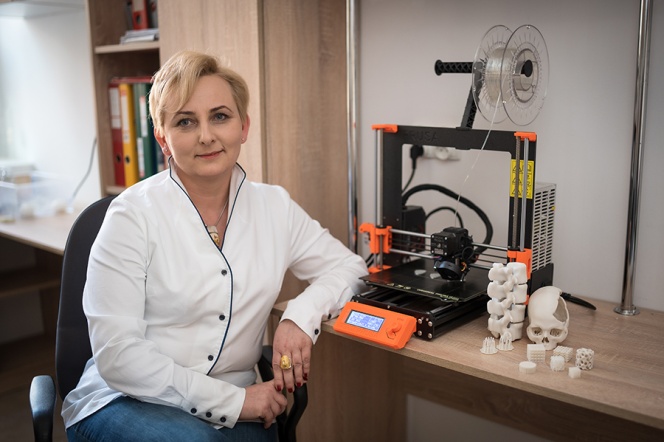Date added: 2022-07-05
Polymers – from algorithm to personalized medical therapy

Targeted therapy, during which the patient does not swallow pills and strain their liver, but has the medicine administered directly where needed, is a chance for a more effective and safer treatment of patients. In many cases, the solution can be polymers – synthetic, natural, biodegradable or biostable materials with broad range of properties.
Polymers can be used in many medical fields: surgery, cardiology, laryngology or dentistry. However, dependent on their application, they can have completely varied properties. Justyna Kucińska-Lipka and her team from the Faculty of Chemistry, are conducting research aimed at designing new biomaterials safe for organisms. In many cases, the materials are biodegradable and capable of releasing active substances supporting targeted treatment where implanted.
– We design, mold and test polymers with various properties, adjusted to different needs – explains the researcher. – An implant used for lost bone tissue, for example, has to be biodegradable, resorb in the organism over the intended period of time, proportionally to the regeneration of the bone loss. Hip implant, on the other hand, requires completely different properties, cannot degrade – needs to be biostable. For both implants, however, our goal is to support the healing process, not only by mechanical implantation, but also by using additional healing substances, e.g. hydroxyapatite. In the case of bone tissue loss implant, the substance can be released while dissolving. The biostable implant, on the other hand, can be covered with hydrogel.
From design to print
By selecting the appropriate substrates and the molar rations between them, the researchers are able to obtain materials that have different degradation time and a very wide range of physico-chemical and mechanical properties. They use computational modeling to facilitate the design of a material with specific features, which subsequently is used to create prototypes of implants or tissue scaffolds on 3D printer. Printing what has been designed by algorithm allows to verify the consistency of theoretical properties with the actual ones.
– The properties of our product are influenced not only by the material it is made of, but also the selected 3D printing method - explains Justyna Kucińska-Lipka. – There are several types of 3D printing technologies: filament, granulate or polylactide resin using UV light. The same material, subjected to a different technological treatment, can significantly change its properties. We already have a confirmed research that in printing with filament, the rate of implant degradation is influenced by the density of the filling. If density of filling exceeds 58%, the degradation time will be proportional to bone healing. The 48% filling is used to create polyurethane dressings for wounds that are difficult to heal. In the case of scaffolds used in regeneration of soft tissues, the filling should be at the level of 25%.
At the intersection of chemistry and medicine
The research team led by Justyna Kucińska-Lipka collaborates with researchers from the Medical University of Gdańsk, i.a. when creating multilayer hybrid dressings for deep skin lesions or heparin-coated left ventricle assist balloons. These projects are conducted as part of the doctoral dissertation of Paweł Szarlej with the support of Milena Deptuła. PhD from the Division of Embryology at the Department of Anatomy of MUG and co-financed by the Innovation Incubator program of the Ministry of Science and Higher Education.
There is also ongoing research on a nasal implant used after septoplasty, as well as an implant placed in the nasal sinus after sinus surgery, which releases the appropriate dose of steroids and other medicinal substances within 30 days following the surgery and then biodegrades. Thanks to this solution, the patient will be able to avoid changing dressings every day, which is extremely painful and extends the healing process of sensitive tissues inside the nose. This project is carried out as part of the doctoral dissertation of Przemysław Gnatowski, in consultation with Prof. Andrzej Skorek from the Department of Otolaryngology at MUG.
– Simultaneously, we cooperate with the Faculty of Pharmacy at MUG regarding bioprinting research. We are working on optimization of hydrogel pads for cell seeding. This research is the basis of the doctoral dissertation of Edyta Piłat. The research is carried out in the laboratories at MUG under the supervision of Prof. Michał Pikuła from the Laboratory of Tissue Engineering and Regenerative Medicine. Hydrogel bioprints are the future of 3D printing in regenerative medicine. It is already possible to print fragments of soft or cartilage tissues, which, when implanted into the human body, perform a function such as natural tissues.
Research on new materials is conducted within the scope of several projects, including "Initiative of Excellence - Research University" projects: Radium and Palladium, joined by graduate students: Karolina Gwizdała, Zuzanna Cemka and Aleksandra Myślak.
The entire research is a response to the specific needs of doctors. The projects we conduct are planned to be applied and used in treatment of patients. The research on materials, patent examination and industrial research, are supported by Maciej Sienkiewicz, PhD Eng, a member of Gdańsk Tech Innovation Committee.
– Research on biodegradable materials is constantly expanding and opening up new possibilities. It also brings great satisfaction when we discover the properties of a given material, which can subsequently be used in medicine, cosmetology or other industries and simply serve people - emphasizes Justyna Kucińska-Lipka.
Project name: „Computational modeling of drug release systems - comparison of the model properties and 3D prints” within Radium Learning Through Research Programs.
Grant: PLN 23 980
Within the scope of BioTechMed.
Project name: „Improving the quality of microscopic imaging at the Department of Polymer Technology " within Palladium Supporting New R&D Services.
Grant: PLN 135 000
-
2025-11-26
Students scholarship (LoBG)
-
2025-10-24
Success Stories 4 – Gabriela
-
2025-09-09
PhD student scholarship (DoECaS)



